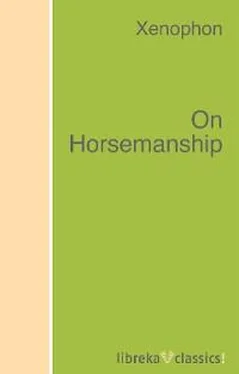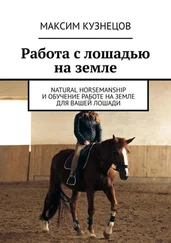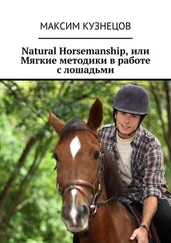Xenophon - On Horsemanship
Здесь есть возможность читать онлайн «Xenophon - On Horsemanship» — ознакомительный отрывок электронной книги совершенно бесплатно, а после прочтения отрывка купить полную версию. В некоторых случаях можно слушать аудио, скачать через торрент в формате fb2 и присутствует краткое содержание. Жанр: unrecognised, на английском языке. Описание произведения, (предисловие) а так же отзывы посетителей доступны на портале библиотеки ЛибКат.
- Название:On Horsemanship
- Автор:
- Жанр:
- Год:неизвестен
- ISBN:нет данных
- Рейтинг книги:5 / 5. Голосов: 1
-
Избранное:Добавить в избранное
- Отзывы:
-
Ваша оценка:
- 100
- 1
- 2
- 3
- 4
- 5
On Horsemanship: краткое содержание, описание и аннотация
Предлагаем к чтению аннотацию, описание, краткое содержание или предисловие (зависит от того, что написал сам автор книги «On Horsemanship»). Если вы не нашли необходимую информацию о книге — напишите в комментариях, мы постараемся отыскать её.
On Horsemanship — читать онлайн ознакомительный отрывок
Ниже представлен текст книги, разбитый по страницам. Система сохранения места последней прочитанной страницы, позволяет с удобством читать онлайн бесплатно книгу «On Horsemanship», без необходимости каждый раз заново искать на чём Вы остановились. Поставьте закладку, и сможете в любой момент перейти на страницу, на которой закончили чтение.
Интервал:
Закладка:
Titel: On Horsemanship
von William Shakespeare, H. G. Wells, Henry Van Dyke, Thomas Carlyle, Oscar Wilde, Joseph Conrad, Henry James, Anthony Hope, Henry Fielding, Giraldus Cambrensis, Daniel Defoe, Grammaticus Saxo, Edgar Rice Burroughs, Hugh Lofting, Agatha Christie, Sinclair Lewis, Eugène Brieux, Upton Sinclair, Booth Tarkington, Sax Rohmer, Jack London, Anna Katharine Green, Sara Jeannette Duncan, Xenophon
ISBN 978-3-7429-1121-6
Alle Rechte vorbehalten.
Es ist ohne vorherige schriftliche Erlaubnis nicht gestattet, dieses Werk im Ganzen oder in Teilen zu vervielfältigen oder zu veröffentlichen.
ON HORSEMANSHIP
By Xenophon
Translation by H. G. Dakyns
Contents
PREPARER'S NOTE Contents PREPARER'S NOTE ON HORSEMANSHIP ON HORSEMANSHIP |
PREPARER'S NOTE
This was typed from Dakyns' series, "The Works of Xenophon," a four-volume set. The complete list of Xenophon's works (though there is doubt about some of these) is:
ON HORSEMANSHIP
I
Claiming to have attained some proficiency in horsemanship (1) ourselves, as the result of long experience in the field, our wish is to explain, for the benefit of our younger friends, what we conceive to be the most correct method of dealing with horses.
There is, it is true, a treatise on horsemanship written by Simon, the same who dedicated the bronze horse near the Eleusinion in Athens (2) with a representation of his exploits engraved in relief on the pedestal. (3) But we shall not on that account expunge from our treatise any conclusions in which we happen to agree with that author; on the contrary we shall hand them on with still greater pleasure to our friends, in the belief that we shall only gain in authority from the fact that so great an expert in horsemanship held similar views to our own; whilst with regard to matters omitted in his treatise, we shall endeavour to supply them.
{andres ippes, paragenesthe nun o kairos, o Simon, o Panaiti, ouk elate pros to dexion keras};
bears the name.
As our first topic we shall deal with the question, how a man may best avoid being cheated in the purchase of a horse.
Take the case of a foal as yet unbroken: it is plain that our scrutiny must begin with the body; an animal that has never yet been mounted can but present the vaguest indications of spirit. Confining ourselves therefore to the body, the first point to examine, we maintain, will be the feet. Just as a house would be of little use, however beautiful its upper stories, if the underlying foundations were not what they ought to be, so there is little use to be extracted from a horse, and in particular a war-horse, (4) if unsound in his feet, however excellent his other points; since he could not turn a single one of them to good account. (5)
regibus hic mos est: ubi equos mercantur, opertos inspiciunt, ne, si facies, ut saepe, decora molli fulta pede est, emptorem inducat hiantem, quod pulchrae clunes, breve quod caput, ardua cervix.
and see Virg. "Georg." iii. 72 foll.
In testing the feet the first thing to examine will be the horny portion of the hoof. For soundness of foot a thick horn is far better than a thin. Again it is important to notice whether the hoofs are high both before and behind, or flat to the ground; for a high hoof keeps the "frog," (6) as it is called, well off the ground; whereas a low hoof treads equally with the stoutest and softest part of the foot alike, the gait resembling that of a bandy-legged man. (7) "You may tell a good foot clearly by the ring," says Simon happily; (8) for the hollow hoof rings like a cymbal against the solid earth. (9)
And now that we have begun with the feet, let us ascend from this point to the rest of the body. The bones (10) above the hoof and below the fetlock must not be too straight, like those of a goat; through not being properly elastic, (11) legs of this type will jar the rider, and are more liable to become inflamed. On the other hand, these bones must not be too low, or else the fetlock will be abraded or lacerated when the horse is galloped over clods and stones.
The bones of the shanks (12) ought to be thick, being as they are the columns on which the body rests; thick in themselves, that is, not puffed out with veins or flesh; or else in riding over hard ground they will inevitably be surcharged with blood, and varicose conditions be set up, (13) the legs becoming thick and puffy, whilst the skin recedes; and with this loosening of the skin the back sinew (14) is very apt to start and render the horse lame.
If the young horse in walking bends his knees flexibly, you may safely conjecture that when he comes to be ridden he will have flexible legs, since the quality of suppleness invariably increases with age. (15) Supple knees are highly esteemed and with good reason, rendering as they do the horse less liable to stumble or break down from fatigue than those of stiffer build.
Coming to the thighs below the shoulder-blades, (16) or arms, these if thick and muscular present a stronger and handsomer appearance, just as in the case of a human being. Again, a comparatively broad chest is better alike for strength and beauty, and better adapted to carry the legs well asunder, so that they will not overlap and interfere with one another. Again, the neck should not be set on dropping forward from the chest, like a boar's, but, like that of a game-cock rather, it should shoot upwards to the crest, and be slack (17) along the curvature; whilst the head should be bony and the jawbone small. In this way the neck will be well in front of the rider, and the eye will command what lies before the horse's feet. A horse, moreover, of this build, however spirited, will be least capable of overmastering the rider, (18) since it is not by arching but by stretching out his neck and head that a horse endeavours to assert his power. (19)
It is important also to observe whether the jaws are soft or hard on one or other side, since as a rule a horse with unequal jaws (20) is liable to become hard-mouthed on one side.
Again, a prominent rather than a sunken eye is suggestive of alertness, and a horse of this type will have a wider range of vision.
And so of the nostrils: a wide-dilated nostril is at once better than a contracted one for respiration, and gives the animal a fiercer aspect. Note how, for instance, when one stallion is enraged against another, or when his spirit chafes in being ridden, (21) the nostrils at once become dilated.
A comparatively large crest and small ears give a more typical and horse-like appearance to the head, whilst lofty withers again allow the rider a surer seat and a stronger adhesion between the shoulders and the body. (22)
A "double spine," (23) again, is at once softer to sit on than a single, and more pleasing to the eye. So, too, a fairly deep side somewhat rounded towards the belly (24) will render the animal at once easier to sit and stronger, and as a general rule better able to digest his food. (25)
The broader and shorter the loins the more easily will the horse raise his forequarters and bring up his hindquarters under him. Given these points, moreover, the belly will appear as small as possible, a portion of the body which if large is partly a disfigurement and partly tends to make the horse less strong and capable of carrying weight. (26)
The quarters should be broad and fleshy in correspondence with the sides and chest, and if they are also firm and solid throughout they will be all the lighter for the racecourse, and will render the horse in every way more fleet.
To come to the thighs (and buttocks): (27) if the horse have these separated by a broad line of demarcation (28) he will be able to plant his hind-legs under him with a good gap between; (29) and in so doing will assume a posture (30) and a gait in action at once prouder and more firmly balanced, and in every way appear to the best advantage.
Читать дальшеИнтервал:
Закладка:
Похожие книги на «On Horsemanship»
Представляем Вашему вниманию похожие книги на «On Horsemanship» списком для выбора. Мы отобрали схожую по названию и смыслу литературу в надежде предоставить читателям больше вариантов отыскать новые, интересные, ещё непрочитанные произведения.
Обсуждение, отзывы о книге «On Horsemanship» и просто собственные мнения читателей. Оставьте ваши комментарии, напишите, что Вы думаете о произведении, его смысле или главных героях. Укажите что конкретно понравилось, а что нет, и почему Вы так считаете.











